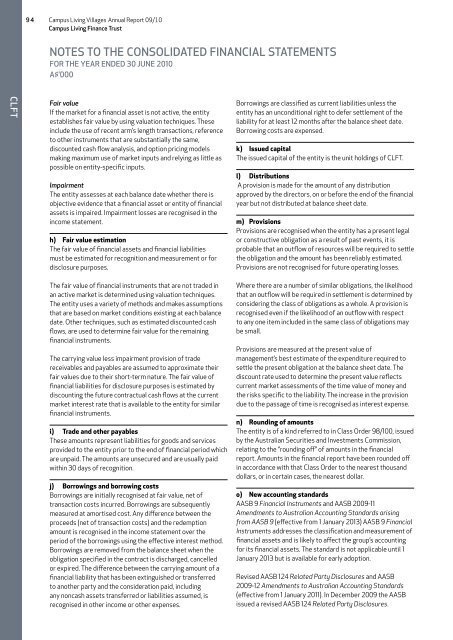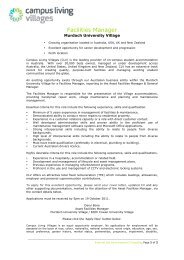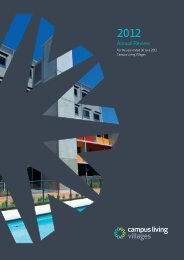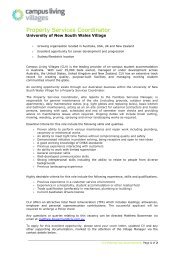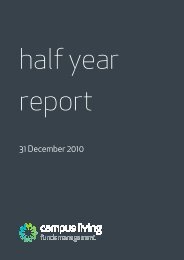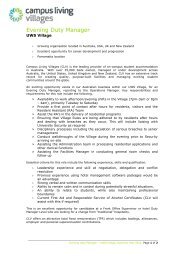Annual Report - Campus Living Villages
Annual Report - Campus Living Villages
Annual Report - Campus Living Villages
You also want an ePaper? Increase the reach of your titles
YUMPU automatically turns print PDFs into web optimized ePapers that Google loves.
9 4 <strong>Campus</strong> <strong>Living</strong> <strong>Villages</strong> <strong>Annual</strong> <strong>Report</strong> 09/10<br />
<strong>Campus</strong> <strong>Living</strong> Finance Trust<br />
NOTES TO THE CONSOLIDATED FINANCIAL STATEMENTS<br />
FOR THE YEAR ENDED 30 JUNE 2010<br />
A$’000<br />
CLFT<br />
Fair value<br />
If the market for a financial asset is not active, the entity<br />
establishes fair value by using valuation techniques. These<br />
include the use of recent arm’s length transactions, reference<br />
to other instruments that are substantially the same,<br />
discounted cash flow analysis, and option pricing models<br />
making maximum use of market inputs and relying as little as<br />
possible on entity-specific inputs.<br />
Impairment<br />
The entity assesses at each balance date whether there is<br />
objective evidence that a financial asset or entity of financial<br />
assets is impaired. Impairment losses are recognised in the<br />
income statement.<br />
h) Fair value estimation<br />
The fair value of financial assets and financial liabilities<br />
must be estimated for recognition and measurement or for<br />
disclosure purposes.<br />
Borrowings are classified as current liabilities unless the<br />
entity has an unconditional right to defer settlement of the<br />
liability for at least 12 months after the balance sheet date.<br />
Borrowing costs are expensed.<br />
k) Issued capital<br />
The issued capital of the entity is the unit holdings of CLFT.<br />
l) Distributions<br />
A provision is made for the amount of any distribution<br />
approved by the directors, on or before the end of the financial<br />
year but not distributed at balance sheet date.<br />
m) Provisions<br />
Provisions are recognised when the entity has a present legal<br />
or constructive obligation as a result of past events, it is<br />
probable that an outflow of resources will be required to settle<br />
the obligation and the amount has been reliably estimated.<br />
Provisions are not recognised for future operating losses.<br />
The fair value of financial instruments that are not traded in<br />
an active market is determined using valuation techniques.<br />
The entity uses a variety of methods and makes assumptions<br />
that are based on market conditions existing at each balance<br />
date. Other techniques, such as estimated discounted cash<br />
flows, are used to determine fair value for the remaining<br />
financial instruments.<br />
The carrying value less impairment provision of trade<br />
receivables and payables are assumed to approximate their<br />
fair values due to their short-term nature. The fair value of<br />
financial liabilities for disclosure purposes is estimated by<br />
discounting the future contractual cash flows at the current<br />
market interest rate that is available to the entity for similar<br />
financial instruments.<br />
i) Trade and other payables<br />
These amounts represent liabilities for goods and services<br />
provided to the entity prior to the end of financial period which<br />
are unpaid. The amounts are unsecured and are usually paid<br />
within 30 days of recognition.<br />
j) Borrowings and borrowing costs<br />
Borrowings are initially recognised at fair value, net of<br />
transaction costs incurred. Borrowings are subsequently<br />
measured at amortised cost. Any difference between the<br />
proceeds (net of transaction costs) and the redemption<br />
amount is recognised in the income statement over the<br />
period of the borrowings using the effective interest method.<br />
Borrowings are removed from the balance sheet when the<br />
obligation specified in the contract is discharged, cancelled<br />
or expired. The difference between the carrying amount of a<br />
financial liability that has been extinguished or transferred<br />
to another party and the consideration paid, including<br />
any noncash assets transferred or liabilities assumed, is<br />
recognised in other income or other expenses.<br />
Where there are a number of similar obligations, the likelihood<br />
that an outflow will be required in settlement is determined by<br />
considering the class of obligations as a whole. A provision is<br />
recognised even if the likelihood of an outflow with respect<br />
to any one item included in the same class of obligations may<br />
be small.<br />
Provisions are measured at the present value of<br />
management’s best estimate of the expenditure required to<br />
settle the present obligation at the balance sheet date. The<br />
discount rate used to determine the present value reflects<br />
current market assessments of the time value of money and<br />
the risks specific to the liability. The increase in the provision<br />
due to the passage of time is recognised as interest expense.<br />
n) Rounding of amounts<br />
The entity is of a kind referred to in Class Order 98/100, issued<br />
by the Australian Securities and Investments Commission,<br />
relating to the ‘’rounding off’’ of amounts in the financial<br />
report. Amounts in the financial report have been rounded off<br />
in accordance with that Class Order to the nearest thousand<br />
dollars, or in certain cases, the nearest dollar.<br />
o) New accounting standards<br />
AASB 9 Financial Instruments and AASB 2009-11<br />
Amendments to Australian Accounting Standards arising<br />
from AASB 9 (effective from 1 January 2013) AASB 9 Financial<br />
Instruments addresses the classification and measurement of<br />
financial assets and is likely to affect the group’s accounting<br />
for its financial assets. The standard is not applicable until 1<br />
January 2013 but is available for early adoption.<br />
Revised AASB 124 Related Party Disclosures and AASB<br />
2009-12 Amendments to Australian Accounting Standards<br />
(effective from 1 January 2011). In December 2009 the AASB<br />
issued a revised AASB 124 Related Party Disclosures.


